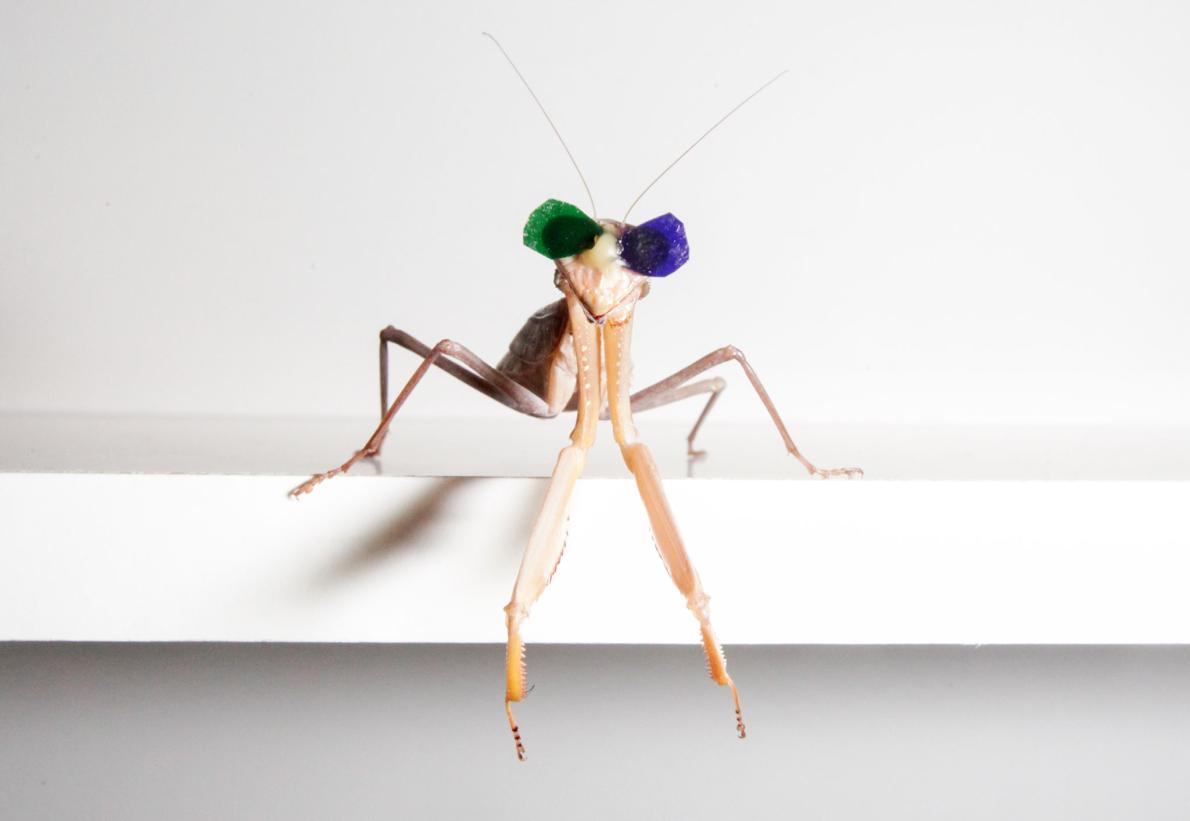
Stereo, or 3D, vision is what enables humans to gauge the depth and distance of surrounding objects. The right and left eye capture slightly different images and send them to the brain, which merges them and then calculates the proximity of everything in the vicinity. The ability, which requires an intricate network of neurons and lots of processing power, can also be found in a select group of animals like cats, horses, owls, and sheep, as well as one insect — the praying mantis.
The insect’s capability, discovered in the mid-1980s, was particularly intriguing to Jenny Read given that its tiny brain has just one million neurons. In comparison, humans have 100,000 times more. Curious to see how the praying mantises process this complex task, the vision science professor at the UK’s New Castle University decided to investigate.

She and research associate Dr. Vivek Nityananda began by creating a custom pair of tiny 3D glasses that were fitted with a blue and green filter, so that the praying mantis could see a different image in each eye. While that was easy enough, putting them on the insect, whose only ear sits at the center of its chest, was a little trickier. Nityananda first placed the insect’s cage in a freezer for a few minutes to “chill” the mantis’ legs, which he then stuck to a board with the help of some play-doh. Once the praying mantis was completely immobile, the scientist slid on the glasses. A drop of beeswax between the eyes ensured they would stay glued in place for short periods of time.
The bespectacled mantis was then suspended upside down — its favorite hunting position — about 4 inches away from a computer screen which was playing some specially created “bug” movies. The first featured a set of moving dots against a cluttered dotted background. Sure enough, the insect tried to pounce upon, what it believed was a beetle, each time the dots came within striking distance. This proved without a doubt that praying mantises possess 3D vision. The second test was more challenging for the insect because while both eyes could observe the moving target, each registered a different background. The researchers found that the praying mantis was unfazed by the confusing backdrop and continued to pursue its “beetle.”
This came as a big surprise. That’s because in order for stereo vision to work in humans and animals, the images from both eyes have to match up. For instance, if one eye sees a forest and the other sees a road, the brain is unable to calculate the depth and distance of objects even if the movement is occurring in the same spot in both scenes. Read says, [unlike humans],“They [praying mantis] aren’t trying to match up the brightness pattern of left and right. They’re trying to match up places where things are moving.”

While this means the insects do not have the capability to perceive depth and distance when there is no movement, Nityananda says, “Mantises only attack moving prey, so their 3D doesn’t need to work in still images.” The researchers argue that the insects’ form of 3D vision may be better than ours, since it even works in conditions (like seeing different images) where the complex human stereo vision fails. Read quips, “Having an insect outperform our undergraduates on it [stereo vision] was quite fun.”
The insect’s unique 3D vision has motivated Read and Nityananda to design a mantis-inspired algorithm to help improve machine vision. Fellow team member from the School of Engineering Dr. Ghaith Tarawneh says, “Many robots use stereo vision to help them navigate, but this is usually based on complex human stereo. Since insect brains are so tiny, their form of stereo vision can’t require much computer processing. This means it could find useful applications in low-power autonomous robots.”
The discovery, published in the journal Current Biology on February 8, 2018, has led the researchers to suspect that the praying mantis may not be the only insect capable of stereo vision. They believe other predatory creatures such as robber flies and dragonflies may also have the capability. Unfortunately, they may never find out for sure because fitting 3D glasses on these active insects would be next to impossible.
Resources: ncl.ac.uk, nationalgeographic.com,theatlantic.com, theverge.com
